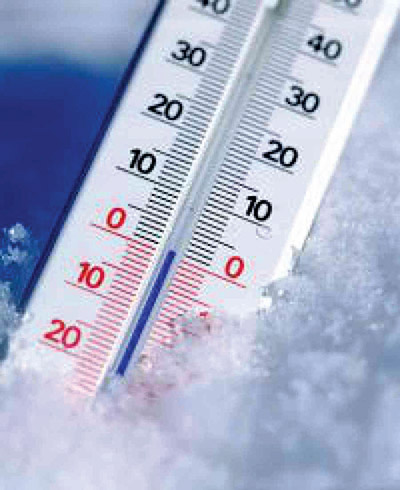
(With thanks to “Emergency Care in the Streets – 5th ed.” Nancy Caroline, MD (dec.), one of the original paramedic trainers in the US and later first director of Magen David Adom in Israel.)
This has been a record-cold series of weeks, and the winter has just begun. Keeping safe and healthy in this environment should make us cognizant of how our bodies maintain and lose heat, and what types of cold emergencies are faced in this environment.
The loss of body heat happens every moment of every day for all of us. How we manage to maintain our normal 98.6 F temperature helps us stay healthy. Body heat is lost in the following ways:
- Radiation: Heat is constantly lost through the surface of our skin, with at least 65 percent of that heat radiating from the shoulders up. (Scarfs and hats are not optional.)
- Conduction: Heat is transferred from our “warm” body surfaces to surfaces/objects that are colder, e.g., the concrete pavement, wet or sweat-soaked clothing (especially wet gloves and socks), water.
- Convection: Moving air/wind draws heat away from the body faster than still air; therefore, knowing “wind-chill factor” helps know how cold it really feels as heat is drawn away from the body.
- Evaporation: The heat of the body takes the moisture of the body and clothing and converts it from liquid to vapor/gas. This “loss” of heat helps cool the body.
- Respiration: Although cold air entering the body is rapidly warmed in our airway, exhaled warm air takes some of that needed heat back out.
To offset these examples of heat loss, our bodies utilize some mechanisms to create/maintain heat. (Note: The body, for this topic, comprises two parts: the core and the shell.) It is the “job” of the brain to maintain normal core temperature at all costs. Shivering is one example of the body’s reaction to environmental cold. By making muscles active, heat production is increased; exercise will do that two to three times more effectively. Another body reaction is to decrease blood flow to the “shell,” thereby reducing the “cold” that is returned through blood vessels to the “core” of the body (and the temperature-sensitive brain).
Cold-related “emergencies”:
- Frostbite can only occur when temperatures are 32 degrees Fahrenheit or less. Frostbite in its earliest stage is called “frostnip,” the cold affecting those exposed areas that return “cooler” blood to the core. Ears, nose, fingers and toes: We all have noticed they redden first when we are outside too long. That reddening is the body’s immediate response to sensing that “colder” blood is returning to the core. The brain signals surface vessels to dilate, expand to warm the area and hopefully return warmer blood. We often “self-treat” these areas by covering our ears and nose, blowing warm air onto our hands and fingers or stamping our feet. However, when this does not help, we are out too long or we don’t change wet socks/gloves, the brain then “shuts down” these outer vessels to preserve core temperature, and the fingers, toes, ears and nose now take on a pale waxy appearance as water in surface cells freezes and the skin becomes “frostbitten,” either superficially or more deeply. The treatment for superficial frostbite (outer skin layer is pale and somewhat stiff to gentle touch) is to remove the person from the cold environment, gently rewarm part(s), do not use excessive heat, do not rub or massage area(s), cover any blisters with dry and sterile dressings, get victim to hospital.
- Deep frostbite is deeper freezing beyond surface tissue and is cause for medical emergency and rapid transport.
- Hypothermia is a condition where the core temperature of the body begins to decrease from the normal 98.6 F. (Note: This condition does not have to occur in freezing/sub-freezing temperatures; it can occasionally occur in warm(er) climates—with water generally the cause. Think being in a swimming pool, lake or ocean in the summer for two to three hours, and then coming out. Chilled and shivering?? Hypothermia.)
Exposure to colder environments that lower core temperature can cause lethargy, slowing of heart rate, unconsciousness and cardiac arrest. The appropriate response involves warming the person; dry clothing; blankets (making sure the surface he/she is lying on is also insulated—blankets therefore above and below person); warm fluids not hot—especially with some added sugar to increase metabolism; avoiding anything with caffeine, no alcohol (which might feel “warm” going down, but reduces the shivering stimulus/heat-producer).
Above all, use common sense when you know you will be exposed to the cold—and if possible, always have someone else with you.
Stay safe and stay warm this winter season.
By Bob Meyer
Bob Meyer is an EMT and a member of TVAC, as well as a life-long educator/EMS educator.













